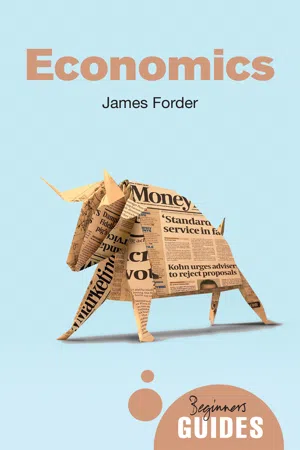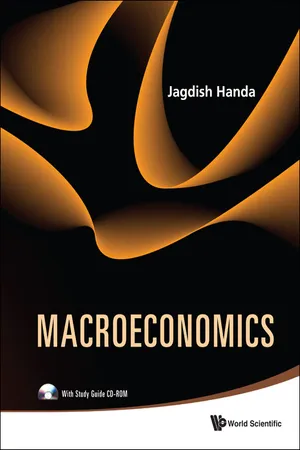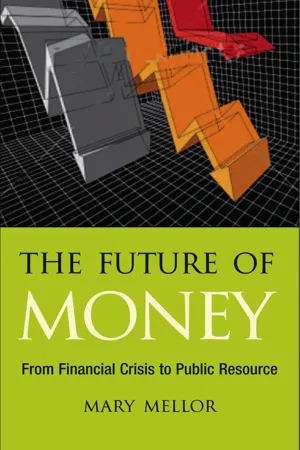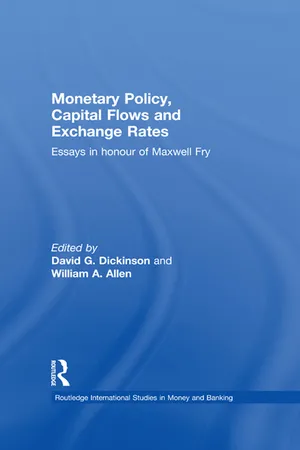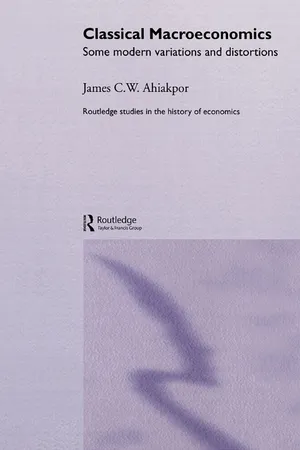Economics
Money as a Store of Value
Money as a store of value refers to its function as a way to hold purchasing power over time. In this context, money serves as a medium for saving and wealth preservation. By maintaining its value over time, money allows individuals and businesses to store their wealth and use it for future transactions or investments.
Written by Perlego with AI-assistance
Related key terms
6 Key excerpts on "Money as a Store of Value"
- eBook - ePub
Economics
A Beginner's Guide
- James Forder(Author)
- 2016(Publication Date)
- Oneworld Publications(Publisher)
5 Money and banksSomething that might seem peculiar about the discussion so far is that there has hardly been a mention of money. It appears as a way of measuring prices, and perhaps as something that people like to make, but apparently not as an essential component of economics at all. Part of the explanation is that – as we shall see – although money is obviously an important aspect of the functioning of modern economies, there are large parts of economic analysis where it is not nearly so important as might be supposed. It does nevertheless raise some issues of its own – issues concerning the nature of money itself; what makes something ‘money’ rather than not money; where is it that money comes from; how it is related to economic activity; and what kind of policy actions might be called for, and when?Definition of moneyDefining money is a surprisingly difficult task. The first point, though, is that in ordinary English the word ‘money’ is certainly used more broadly than it is in economics. As I have just said, ‘money’ is sometimes treated as the thing that some people like to make. But that is not an economist’s usage. Really, what those people are seeking is wealth, or perhaps income. Similarly, we might say ‘Mr Gatsby has a great deal of money’ – but it would be unlikely to mean that his wallet was at that moment particularly full.Confusion is taken further when economics textbooks provide a list of the functions of money. It functions, they say, as a unit of account, a medium of exchange, and as a store of value. ‘Unit of account’ means the measuring rod of economic value – the units in which prices are quoted. A ‘medium of exchange’ (or ‘transactions medium’) is the device commonly used to make payments, and a ‘store of value’ is a way of taking the power to make purchases that we have today, and moving that power to purchase into the future. But those are the functions of money – they are what money does. They do not exactly tell us what money is - eBook - ePub
Macroeconomics
(With Study Guide CD-ROM)
- Jagdish Handa(Author)
- 2010(Publication Date)
- WSPC(Publisher)
Money is not itself the name of a particular asset and is best defined independently of the particular assets that may exist in the economy at any one time, since the assets which function as money tend to change over time in any given country and among countries. At a theoretical level, money is defined in terms of the functions that it performs. The traditional specification of these functions is:(i) medium of exchange/payments, (ii) store of value, sometimes specified as a temporary store of value or temporary abode of purchasing power (iii) standard of deferred payments, and (iv) unit of account.Of these functions, the medium of payments is the most essential function of money. Any asset that does not directly perform this function — or cannot indirectly perform it through a quick and costless transfer into a medium of exchange — cannot be designated as money. A developed economy usually has many financial instruments that can perform such a role, though some do so better than others. The particular instruments that perform this role vary over time, with currency being the only or main medium of exchange early in the evolution of monetary economies. It is supplemented by demand deposits with the arrival of the banking system and then by an increasing array of financial assets as other financial intermediaries become established.2.1.2 The practical definitions of moneyHistorically, the definitions of money have measured the quantity of money in the economy as the sum of those items that serve as media of exchange in the economy. However, at any time in a developed monetary economy, there may be other items that do not directly serve as a medium of exchange but are readily convertible into the medium of exchange at little cost and trouble and can simultaneously be a store of value. Such items are close substitutes for the medium of exchange itself. Consequently, there is considerable controversy and disagreement about whether to confine the definition of money to the narrow role of the medium of exchange or to broaden it to include close substitutes for the medium of exchange. - eBook - ePub
The Future of Money
From Financial Crisis to Public Resource
- Mary Mellor(Author)
- 2010(Publication Date)
- Pluto Press(Publisher)
1 WHAT IS MONEY?This is not a straightforward question. Money in its long history has been represented by many different things from precious metals, shells and beads to heavy, largely unmoveable stones. It has been made of substances that have value in themselves such as precious metals or represented by something that has no value in itself such as base metal coin or paper. Its operation has been represented in many ways from cuneiform tablets and tally sticks, to paper or electronic records. Conventional economics sees money as having a number of functions. It is a measure of value (a unit of account), a medium of exchange, a way of making deferred payments and a store of value. Money is seen as evolving with the market system. Barter is often assumed to be the original form of economic exchange with money emerging to solve the problem of finding suitable mutual exchanges. From this perspective, money is the product of pre-existing economic exchange.The chosen commodity needed to be valuable, durable, divisible and portable. Precious metals such as gold and silver were obvious choices. As a result, gold has been particularly resonant for modern conceptions of money. Gold is seen as having an inherent or intrinsic value and was adopted as a basis for money value until comparatively recently. From this ‘metallist’ perspective, the value of money still relates back to gold or some commodity that has intrinsic value although, in practice, money can be represented in many forms, such as base metal coin, paper or electronic record. This view of money leads to the assumption that money can only function effectively if it is scarce and valuable. Douthwaite argues that this view, based on the historical scarcity of gold and silver, has distorted economic theory ever since. It has led to the false idea that money can only be based on a scarce, and therefore valued, resource (1999:33). - eBook - ePub
Paper Money Collapse
The Folly of Elastic Money
- Detlev S. Schlichter(Author)
- 2014(Publication Date)
- Wiley(Publisher)
The skeptical reader may at this point still raise the following objections: First, the case is built on money’s function as the medium of exchange, but standard economic textbooks also ascribe other functions to money, such as a store of value or a unit for accounting and monetary calculation. Second, the changes in money’s purchasing power that result from changes in money demand could be disruptive, as they may impair money’s role as a basis for economic calculation. Maybe it is better to adjust the money supply in response to changes in money demand than to allow money’s price to change. This would make sure that money is a reliable tool for economic calculation. Third, if money production is not needed, how can we account for the growth in banking, which for a long time has included the issuance of money substitutes and fiduciary media, the latter meaning uncovered claims to money proper that are used by the public just like money, for example, demand deposits. How can we account for the fact that the world has moved away from commodity money of fixed supply to paper money of perfectly flexible supply?These are all good and valid questions. We will address each one of them in detail in the course of our investigation. At this juncture it may just be sufficient to make the following points.All additional functions that can be assigned to money are the result of money being the accepted medium of exchange. These functions, important as they are, are derivatives of the medium-of-exchange function. Because money is the medium of exchange and every good or service is traded against money, money prices are ideal for economic calculation. As to money being a vehicle for storing wealth, it is apparent that many other assets can be used for that purpose, too. Many of these have the additional attraction of potentially generating returns over time. Money does not offer any returns. It can therefore compete with other potential storages of wealth only by offering something special, and that is its universal acceptance in exchange for goods and services, its unique marketability, the ability to be exchanged for goods and services faster and more conveniently than any other asset. That, after all, is why it is money. So we are again back to the medium-of-exchange function of the monetary asset.Certain financial assets, in particular high-quality debt claims that are traded in very liquid markets, can sometimes become “near-monies,” and their owners may thus feel a reduced need to hold money proper. But these assets are fundamentally different in that they constitute simultaneously somebody else’s liability and therefore always carry an additional risk. Proper commodity money, such as gold, but also fiat money in the form of irredeemable paper tickets, is a financial asset that is not somebody else’s liability at the same time. The purchasing power of this money varies only with changes in the demand for money and, in the case of paper money, also with changes in its inherently flexible supply. We see here that the inflexibility of supply in the case of commodity money makes it a superior store of value. - William Allen, David Dickinson(Authors)
- 2004(Publication Date)
- Routledge(Publisher)
7 A World without Money and Banking? Andrew Mullineux What is Money?One of the problems with ‘monetarism’ was that money itself had never been properly defined. Milton Friedman (1969) basically argued that ‘money is what money does’. In his view, what money (i.e. monetary growth) does is cause inflation and thus, we could simply define money as the sum of the monetary assets that best correlate (‘explain’) inflation (measured as the rate of increase of some price index e.g. the Retail Price Index in the UK). Clearly there are a number of problems with this approach (not least that correlation does not imply causality) and, to be fair, Friedman and Schwartz (1963), in their impressive monetary history of the US, did suggest that a monetary index of some sort might be more appropriate than a measure of money formed by simply adding together, or summing, various monetary components.In order to answer the question, ‘What is money?’, let me outline some of the economic fundamentals relating to money. There are a number of ways of proceeding towards the definition of money, but perhaps the most influential has been what Hicks (1967) called ‘The Two Triads’ in his ‘Critical Essays’, which explores the relationships between them. ‘The Two Triads’ are listed in Box 7.1 .Box 7.1 What is Money? The Two TriadsTriad 1: The functions of money- Means of payment (settlement) (Medium of exchange) (credit vs money)
- Unit of account (measure of value)
- Store of value – Money and time – Intertemporal consumption – Savings and future consumption – Wealth as accumulated annual savings
To get to grips with Triad 1, it may help to pause and reflect on the euro. It will not be circulating as a currency (notes and coin or cash) for use in day-to-day transactions until January 2002, but is already used for large electronic and cheque-based transactions, involving transfers between bank accounts. It should be noted that the cheques and electronic signals, are not themselves money. They are merely instructions to move ‘money’ from one bank account to another. The euro is, however, fulfilling a unit-of-account function in mainland Europe, if not in the UK. French supermarkets have for some time now been quoting prices in both French francs and euros and this has become the practice in the other countries participating in EMU.- eBook - ePub
- James C. W. Ahiakpor(Author)
- 2004(Publication Date)
- Routledge(Publisher)
He explains that money is “not only a medium of exchange, but…also…a measure of value. It serves as a means of comparing values of different things by expressing them both in a common denominator” (1912:18; italics in original). Also, “money is that particular kind of wealth in terms of which the value of all other kinds of wealth is measured” (5; italics in original). A.C.Pigou defines money in his 1917 restatement of the quantity theory of money in reaction to Fisher’s 1911 exposition of the equation of exchange alternative as “legal-tender money,” the value of whose unit, “like the value of everything else,” is determined by the “general conditions of [its] demand and supply” (1917:39, 40), very much in line with Marshall’s definition. In discussing the supply of money, Pigou refers to “currency” as well as “inconvertible paper notes” issued on the authority of government, and whose “supply curve…is obviously a vertical line fixed in whatever position the government may choose” (53–5). He also describes “bank notes and bank balances against which checks can be drawn” as “titles to legal tender” or “bank money” (42, 47, 60). Similarly, Pigou (1927) retains the distinction between legal-tender money (or currency) and bank money or checkable deposits, although sometimes applying the title money liberally to both, as in his claim that people hold their store of value “in the form of money—mainly, of course, bank-money” (121). Pigou later expands his definition of money to include other assets that may serve as media of exchange, reflecting elements of Fisher’s definition. Thus, he describes money as having “two divisions, current money and bank money,” where his “current money” includes Fisher’s “primary” and “fiduciary” monies, namely, “gold coins, token coins and Bank of England notes” (1949:6). But his “bank money” includes “bank balances… plus overdraft facilities” (ibid.; italics in original)
Learn about this page
Index pages curate the most relevant extracts from our library of academic textbooks. They’ve been created using an in-house natural language model (NLM), each adding context and meaning to key research topics.
